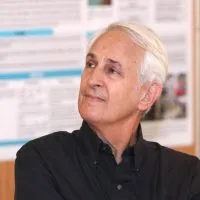The following topics kept me busy over the past five decades:
Communal sleep in Israeli kibbutzim:
As a young researcher, I was influenced by John Bowlby's work with children placed in institutions. In this context, my first research dealt with the effect of communal sleep in kibbutzim on the emotional development of children. The practice of communal sleep created a "natural laboratory" for quasi-experimental research in which basic scientific questions related to the effect of early parental separations on children's development could be better explored. While most children's upbringing conditions in the kibbutz environment were very favorable, sleeping away from parents at night was a significant deviation from the conditions considered critical in the field, for the development of secure parent-child relationships. With my co-workers (initially with Michael Lamb and David Oppenheim and then mainly with Ora Aviezer and Marinus van IJzendoorn, jointly with many graduate students), we studied the impact of these separations in a methodologically sophisticated way, and the findings of our research showed a significant number of children with insecure attachment, when raised in communal sleep, findings that also contributed later to the top-down decision to abolish communal sleep (See items 28, 29, 32, 38, 39, 53, 56, 62, 64, 65, 71, 74, 76, 78, 92, 105).see publications list:
https://drive.google.com/drive/folders/1Tg2RfDaa4GzO64knbX-AqHa-rdBnf7HQ
The findings go hand-in-hand with Bowlby's observations when he visited Israeli kibbutzim in the early 1950s and predicted that "this child-rearing context, though, clearly different from institutional care, might produce higher rates of attachment insecurity". I was so delighted when I learned that this work led me to be bestowed with the "Bowlby-Ainsworth award on attachment research, the New York Attachment Consortium": https://www.centermhp.org/2015-awardees
Foster care
In 2012, the Casey Foundation invited a group of 10 leading experts from around the world to discuss issues of residential care, mainly given the growing concerns that welfare agencies sometimes too easily give up on keeping children with their biological parents or on placing them in foster when in need, and instead they use at-risk residential care. In light of the kibbutz's work, it was rather rewarding to be a member of this study group that concluded with a translational knowledge document: Dozier, M., Kaufman, J. Kobak, R.R., O'Connor, T.G. Sagi-Schwartz, A., Scott, S., Shauffer, C., Smetana, J., van IJzendoorn, M.H, & Zeanah, C.H. (2014)). Consensus statement on group care for children and adolescents. American Journal of Orthopsychiatry, 84 (3), 219-225. See item 121, in the publications list:
https://drive.google.com/drive/folders/1Tg2RfDaa4GzO64knbX-AqHa-rdBnf7HQ
The article was adopted by the American Association for Orthopsychiatry as a consensus document and we hope it will continue to make an impact in various countries, with welfare services recognizing the need to integrate children into foster care rather than institutional settings. The Child Protection Agency in the Ministry of Welfare in Israel adopted this position paper, and later I was invited to serve as a guest editor of the major social work journal in Israel - "Society and Welfare" - to further discuss the issue. See item 129 in thepublications list:
https://drive.google.com/drive/folders/1Tg2RfDaa4GzO64knbX-AqHa-rdBnf7HQ
I trust that we bring here, to the attention of welfare workers who work for the benefit of children who are at serious environmental risk, the study of developmental psychology at its best.
These studies have important implications for a myriad of universal issues: removing children from the home and what children are likely to experience as a result of separation from parents, placement children in non-family settings vis-à-vis foster care, divorce and separating children from one parent (usually the father), timing of adoption, and more. I believe that these studies exemplify an interdisciplinary integration between basic research in the field of child development and issues with implications for the welfare system, namely, translational knowledge. This is being illustrated more in the section regarding foster care.
Divorce
I was privileged to be one of the members in the national public committee to examine the legal aspects of parental responsibility in divorce. Much of the committee's recommendations are based on attachment theory and research, and the influence on changing the thinking about child best interests in the areas of divorce, welfare, and law is noticeable. This effect is reflected in increasing changes both in the activity of social workers and in the general mindset, as well as rulings of family judges and courts of appeal. The consensus statement made by 70 scholars from around the world is noted here: Attachment goes to court: child protection and custody issues, Attachment & Human Development, DOI: 0.1080/14616734.2020.1840762 See item 135 in thepublications list:
https://drive.google.com/drive/folders/1Tg2RfDaa4GzO64knbX-AqHa-rdBnf7HQ
Also note that in the unfortunate context of COVID19, Israel has undergone already several lockdowns. Thanks to this work, "attachment went also to the Israeli government" with a decision that children in divorced families could move between the homes of mothers and fathers, regardless of distance, to maintain contact with both, despite the strict lockdown which included restrictions to move no more than 100 meters away from home.
Day Care Centers
An important derivative of the kibbutz's findings was a growing concern about the impact of prolonged stay in day care centers on the emotional and social development of children, especially during the first two years of life. With a large research grant from NICHD to investigate this issue, we have shed light on the risk on the development of children involved in prolonged stays in low-quality day care centers. See items 49, 73, 81, 96, 105 in thepublications list:
https://drive.google.com/drive/folders/1Tg2RfDaa4GzO64knbX-AqHa-rdBnf7HQ
These findings received much scientific resonance as well as public resonance in Israel. Recognition of this research led the Department of Day Care in the Ministry of Labor and Welfare to invite our team to lead a national project "First Settings" and to prepare a standards document for the supervision of day care centers in Israel. We create here a link between state-of-the-art research in developmental psychology concerning early childhood and the optimization of the well-being of young families and their children who use daycare in Israel.
Trauma
I have also devoted the last three decades to advance trauma research, addressing the place of attachment theory and its implications for prevention and intervention.
Holocaust trauma
As a second generation to the Holocaust and as a concerned citizen, my personal interest in the fate of the Jewish people and the far-reaching impact of the Holocaust, led me to explore, with a number of Israeli graduate students, Dutch and German co-workers (Marian Bakermans-Kranenburg and Marinus van IJzendoorn, and Karin and Klaus Grossmann respectively), in pioneering series of studies the long term effects of brutal loss of both parents on Holocaust child survivors and on second and third generations. These studies revealed the dire impact of these experiences on Holocaust survivors even many decades later. However, surprisingly and remarkably, the studies found that the “second generation” showed no signs of emotional or any other harm, and this was also the case regarding the grandchildren. Contrary to expectations, the studies pointed to the great resilience that characterized the survivors in their functioning as mothers. These data led us to examine both genetic and physiological aspects of this resilience and opened a window for interdisciplinary research and further collaborations. See items 61, 77, 79, 80, 83, 84, 85, 95, 99, 104, 107, 108, 110, 115, 116, 125, 134 in thepublications list:
https://drive.google.com/drive/folders/1Tg2RfDaa4GzO64knbX-AqHa-rdBnf7HQ
In our trauma studies we have also been able to create an important and unique distinction between traumas linked to within the family (e.g., child abuse) versus those associated with factors outside the family (e.g., Holocaust, political violence), thus also targeting differential intervention and policies.
Traumas of war and political violence
I organized an international conference with the support of the International Society for the Study of Behavioral Development, and the fruits of this not obvious Israeli-Palestinian conference were published in a special issue of the International Journal of Behavioral Development, jointly with a Palestinian co-guest editor. In this work, in the context of political violence, I continued to emphasize the theoretical and research innovations, but not less important I created a dialogue between Palestinians and Israelis (including Gaza and West Bank) to discuss the effects of chronic conflict in the region as well as optimal ways to protect children from the distress involved by being exposed to violence and trauma. In this context, I was invited as a Jennings Randolph Senior Fellow at the United States Institute of Peace in Washington, D.C., to further study the original developmental concept "circles of security" as it may bear to conflict resolution and diplomacy. The work is summarized in an article with innovative proposals linking a systemic-ecological model of human development with issues of political violence and it published in: Children of war and peace: A human development perspective. Journal of Conflict Resolution, 56, 933-951, 2012. See item 113 and also 103 in thepublications list:
https://drive.google.com/drive/folders/1Tg2RfDaa4GzO64knbX-AqHa-rdBnf7HQ
Attachment in a cross-cultural context
Over the past three decades, with my Dutch colleagues Marian Bakermans-Kranenburg, Marinus van IJzendoorn, and Judi Mesman, we have addressed cross-cultural issues in the study of attachment. We have shown the universal aspects of attachment theory, even in the context of many diverse cultures in all continents. See items 42, 70, 93, 126, 130, 132 in the publications list https://tinyurl.com/2p8khm5n. Note in particular our chapter in three editions of the Handbook of Attachment which has gained much attention in the field. See items 63, 101, 127 in the publications list https://tinyurl.com/2p8khm5n. The collaborative work on this topic as well as on the kibbutz and the Holocaust trauma led van IJzendoorn and me to receive jointly the Society for Research in Child Development (SRCD):
https://drive.google.com/file/d/1E-tCqDfqdcafBQ75TFTeJppLJOXyXPWe/view
Attachment networks
Over the past several years Or Dagan and I have paid closer attention to infants’ patterns of attachment to both their mothers and fathers and they jointly influence important developmental outcomes. We have noticed that such studies are few, based on small samples, and not well-designed longitudinally. Moreover, we have also noted the mixed results on how infants’ attachment patterns to mothers and fathers affect important developmental outcomes, resulting in theoretical inconsistencies regarding the model that best describes the organization of multiple attachment relationships and their effect on later development. This has become in recent years a hot issue, and in a number of publications we review research on the unsettled issue of infants’ network of attachment to mothers and fathers, and propose explanatory models that can be tested empirically alongside methods likely to be more robust and innovative than those that have been used traditionally. See items 131,133 in thepublications list:
https://drive.google.com/drive/folders/1Tg2RfDaa4GzO64knbX-AqHa-rdBnf7HQ
Also mote the special issue: Dagan, O., Sagi-Schwartz, A., & van IJzendoorn, M. Guest Editors, on Attachment network, New Directions in Child and Adolescent Development.




